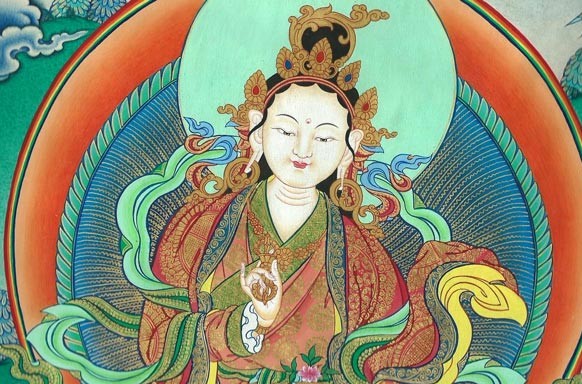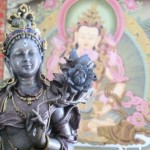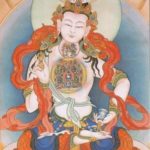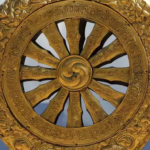Nangsa Obum: Story of a Survivor
This is a brief summary of the legend of Nangsa Obum. She is beaten almost to death and in the end survives and moves on to live a life devoted to liberation of her self and others. Therefore it is a story of a woman overcoming extreme resistance to her spiritual pursuits. Although those around her do not understand and actively work against her, Nangsa Obum’s diligence makes it possible for her to fulfill her highest aspirations in the end. Her story portrays a Buddhist life that is not easy, yet expresses unrelenting pure intention, virtue and determination.
Nangsa Obum (sNang sa ‘Od ‘bum) was born in wealthy family in south western Tibet in the eleventh or twelfth century. She was married to the king’s son, Drakpa Samdrup. However, both the king and the son loved her. Vying for her favor, Nangsa Obum’s legend tells us that the king and his son gave Nangsa Obum the keys to the royal storehouse. Unfortunately, this made the king’s sister jealous, since those keys had previously belonged to this sister. The king’s sister began a campaign against Nangsa Obum.
Nangsa Obum met a traveling yogi and began to turn towards a Buddhist life. Out of jealousy, the king’s sister told the king that Nangsa Obum was being unfaithful. After hearing this, the king beat her and took her son. Due to the physical and emotional trauma of these events, she became depressed and died.
Upon her death, Nangsa Obum met the Buddha of compassion, Avalokiteshvara. He told her that because of her exceeding virtue, he would send her back to continue living. Her legend states that because of this, Nangsa Obum returned from the dead and came back to life.
Changed by this experience she began preaching the Buddhist teachings to her family and servants but they were not receptive to this. They took her son, scorned her and evicted her. Forced into homelessness, eventually she found a Lama, Shakya Gyaltsen, who was willing to teach her. Through training earnestly she became a great yogini.
However, her troubles did not end. Her husband and his father, the king, came after Ngangsa Obum. They showed up at her teacher’s temple with their army, intending to destroy the monastery, kill the disciples and retrieve Nangsa Obum. They were unsuccessful because the Lama used supernatural powers to defend the disciples and their monastery. The legend of Nangsa Obum says that during this display of powers, Nangsa Obum also revealed special powers, flying above the men gathered there. It was only then that her husband and his father realized that she was an emanation of Dorje Phagmo, Vajrayogini. From then on, she was allowed to practice Buddhism and study with her teacher who was supported by the king.
This is my brief summary of the short version of Obum’s life by Schaeffer (see below), who based his version on previous versions. Apparently, Nangsa Obum’s story had appeared in the numerous previous renditions by Gelek Namgyal and Phoebe Harper (1984), Duncan (1955), Waddell (1895), Cunningham (1940) and Bacot (1924).
References:
(1) Allione, Tsultrim. Women Of Wisdom. Revised edition. Ithaca, NY: Snow Lion, 2000. Print.
(2) Gross, Rita M. Buddhism After Patriarchy: A Feminist History, Analysis, and Reconstruction of Buddhism. SUNY Press, 1993. Print.
(3) Schaeffer, Kurtis R. Himalayan Hermitess: The Life of a Tibetan Buddhist Nun. Oxford University Press, 2004. Print.










